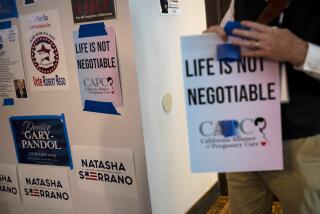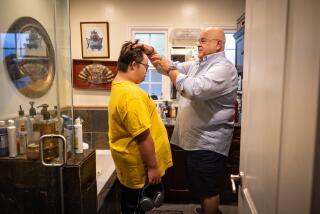School Clinic Born Amid Controversy Now Faces Cutbacks
- Share via
Three years ago, the San Fernando High School health clinic opened amid a firestorm of protest from parents and others angered by plans to provide students with birth control help.
The overwhelmingly Latino and Catholic community organized candlelight vigils and marches, and the Catholic archbishop of Los Angeles condemned the clinic, one of three in the Los Angeles Unified School District.
But today, a lack of funds--a problem the Los Angeles Board of Education took up Monday--has replaced the protests over birth control that were once the biggest threat to the clinics.
“I think at the beginning there were some misunderstandings because there was the impression that all we did here was birth control,” said Jan Marquard, director of the clinic that opened in December, 1987.
“But that’s really not why students are coming here. We do a lot more mental health than we had anticipated.”
In fact, 66% of the visits to the clinic in the 1989-90 school year were for general medical reasons, including treatment for various illnesses, immunizations and physical examinations, Marquard said. Only 7% of the visits were for contraceptive help and pregnancy testing.
Almost a third of the clinic’s workload consisted of mental health-related treatment for students suffering from depression, physical and sexual abuse, gang-related issues and suicidal tendencies. The staff at the clinic makes an average of one referral a week to county authorities for child abuse, Marquard said.
Students can use the clinic only if they return a consent form signed by a parent. About 60% of the 2,764 students at the school last year had the forms on file.
“We’re actually maxed out,” Marquard said. “We really can’t see many more.”
Principal Bart Kricorian said the clinic provides a vital service to the students.
“The reason that the clinic is very successful is because our community . . . doesn’t have access to health care,” he said. Many students at San Fernando High are emigrants from El Salvador, Guatemala and Mexico whose parents don’t have health insurance, he added. “Many of them don’t know of the health services available to them,” he said.
Protests against the clinic stopped soon after it opened. A group called Parents and Students United in the San Fernando Valley, which was formed to stop the clinic, is still in existence, but has moved on to other issues.
“I suppose that after the clinic was operating, contrary to the will of the people, that it kind of broke their hearts,” said Eadie Gieb, spokeswoman for the group. “Once it opened, we knew that our lobbying was for naught.”
In one of the group’s last acts of protest against the clinic, opponents gathered in front of the school more than two years ago for a candlelight vigil and burned a pile of consent forms.
“We were saying, ‘This is what we think of what you’re doing to us,’ ” Gieb said.
With the protests gone and the clinic running at maximum capacity, the biggest worry school officials have is funding.
The San Fernando High clinic, as well as clinics at Los Angeles High in the Wilshire District and Jordan High in Watts, cost between $230,000 and $240,000 each per year. They receive about half their funds from the Robert Wood Johnson Foundation of Princeton, N. J., which guaranteed funding for six years.
The rest of the funding comes from money raised by the school district. But because some grant money is ending and the level of donations is down, the district is projecting a deficit of $80,000 for the three clinics this year. Each program will have to cut $27,000.
The Los Angeles school board agreed Monday to hire a full-time fund-raiser to solicit donations for the clinics and appropriated $66,000 to pay for the position. Officials are hoping that the fund-raiser can bring in enough money from public and private sources not only to keep the clinics operating, but to possibly open clinics at other schools. In addition, the district has formed a nonprofit corporation to support the clinics.
There are no plans at San Fernando High to cut back on staff or days the clinic is open because the reduction can be accomplished by leaving vacant a position for a school health educator.
“This year, we’ll probably be all right,” Marquard said. “But next year, I don’t know, because the deficit is expected to be much greater.”
Kricorian said he is confident that if the school district cannot come up with funds to keep the clinic operating, private corporations and individuals will do so. But if the clinic must close, it would be a great loss, he said.
“If it were to happen, it would be a catastrophe for us because we would not be able to serve our students at all,” he said.
More to Read
Sign up for Essential California
The most important California stories and recommendations in your inbox every morning.
You may occasionally receive promotional content from the Los Angeles Times.










